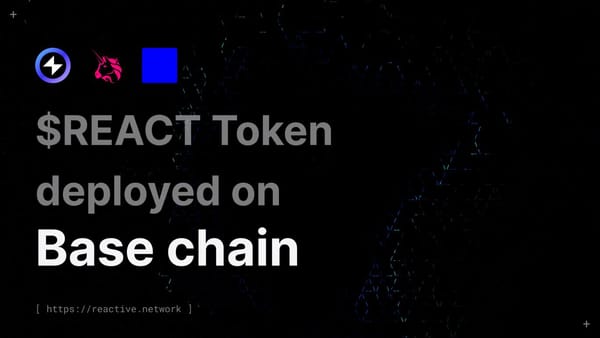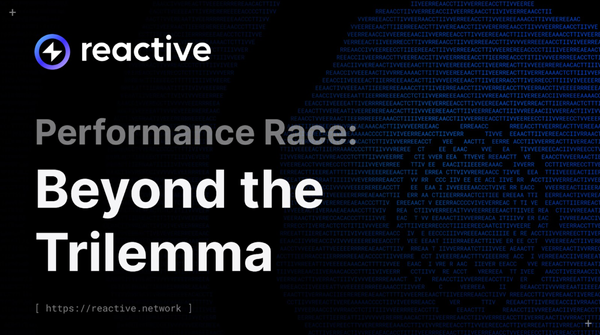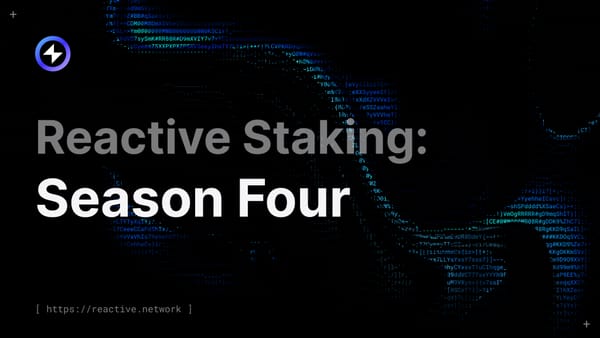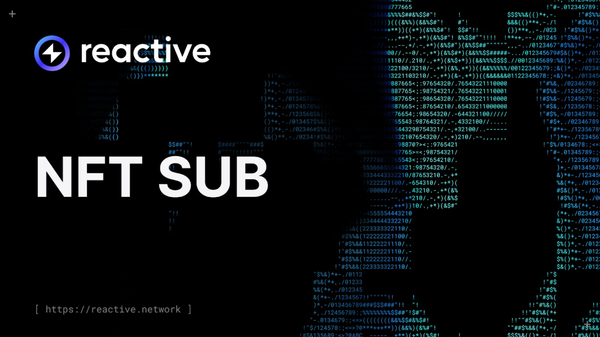Reactive Network Staking: Mechanics & APY
Reactive Network hits 26M REACT staked in just 22 days, with updated APY data, staking mechanics, and a full step-by-step guide to help users migrate and stake confidently.
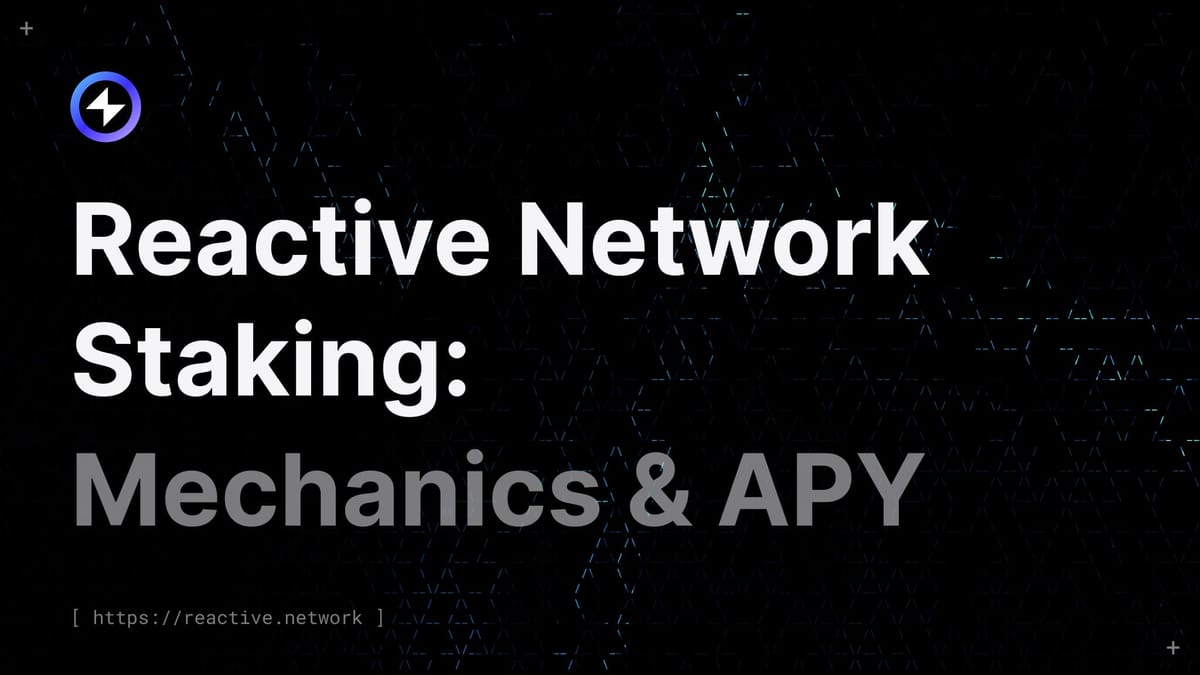
Milestone Update
After just 22 days, the Reactive Network is closing in on 26 million REACT staked. We are incredibly grateful to our community for this strong vote of confidence in the network’s ambitions and its potential as a unique events-based execution layer in the broader ecosystem.
Launching the Reactive Network: A Leap into the Unknown
As previously discussed, nothing like the Reactive Network existed before. Building an events-based execution layer required our team to design new components—such as relayers, sequencers, and validators—completely from scratch.
At this stage, the Reactive Network can be viewed as a “mainnet beta,” meaning our team still maintains direct oversight to ensure stability and mitigate risk. This is a standard practice for early-stage proof-of-stake chains, which typically begin with limited validators before evolving into an increasingly decentralized model.
Why We Avoided Pre-Launch APY Guarantees
We initially provided a projected APY range of 15–20% to account for potential uncertainties (e.g., validator or relayer malfunctions). These could have impacted overall rewards if slashing or downtime penalties were triggered. Now that the network has been live and stable for more than 10 days, we have collected enough real-world data to provide a more definitive APY on the dashboard.
Staking APY Going Forward
Reactive Network uses a delegated staking mechanism. In simple terms, users “delegate” or lend their tokens to validators who stake on their behalf (much like Lido on Ethereum). While we continue to refine and upgrade the network under this mainnet beta phase, risk and operational costs are primarily borne by the core team—a common reality for new proof-of-stake initiatives prior to the introduction of a fully open validator set. All of these have to be accounted for before rewards can be calculated for delegated stakers.
Updated APY Figures
- Total Staking Pool for First 6 Months: 20% of validator rewards | est. 4.6M $REACT
- Effective Annual Yield at Current Levels: ~35.7%
Rewards will be distributed quarterly, meaning that users who reinvest (or “re-stake”) rewards each quarter can compound returns for an effective annual yield slightly above 35.7%. (Exact compounding yield may vary based on quarterly participation and total stake.)
At the end of the first 6 months, Reactive Network aims to open validation to external partners as part of our journey towards decentralisation, at which point $REACT Holders can choose their validator options. Reactive Network will also re-adjust the shared validator rewards based on market conditions on its own validator network.
Disclaimer: APY is not guaranteed and may fluctuate depending on network conditions, validator performance, or changes to protocol parameters over time.
Sustainability & Network Growth
Any portion of validator rewards not allocated to stakers is directed toward:
- Technical Expenses: Running, Maintaining, and Upgrading Validator Nodes
- Developer Growth Fund
- Hackathon Bounties
These initiatives help grow the Reactive Network ecosystem, support innovative projects, and encourage continued experimentation and development. Importantly, validator rewards do not go to the team or operational expenses; instead, they are solely reinvested in ecosystem resilience and expansion.
Community APY Considerations
Our key objectives in designing the APY and reward structure are:
- Rewarding staking participants with a strong yield
- Ensuring $REACT remains attractive to new participants
- Driving sustainable, long-term growth of the Reactive Network
We believe that the current yield distribution strikes a balanced approach, simultaneously rewarding existing stakers, encouraging new investors, and supporting the network’s long-term health as a leading events-based automation and interoperability platform. The team will monitor the APY over time and make adjustments as necessary—always keeping our community informed and involved.
Typical Staking Market Yields
Below is an updated table of estimated annual percentage yields (APYs) for running validators or staking on various Layer 1/Layer 2 networks. These figures are approximations and can change based on market conditions, network demands, token inflation rates, and protocol decisions. Always verify with official sources or well-known staking providers before making any decisions.
| Network | Layer | Typical Validator / Staking APY | Notes |
|---|---|---|---|
| Ethereum (ETH) | L1 | ~2–4% | Requires 32 ETH for a solo validator. Staking services & pools available. |
| Cardano (ADA) | L1 | ~2–4% | Delegation to stake pools is common. No minimum stake required. |
| Polkadot (DOT) | L1 | ~10–15% | Active nomination increases APY. Minimum stake may vary. |
| Cosmos (ATOM) | L1 | ~15–20% | Rewards vary with on-chain parameters and inflation. Delegating to reputable validators is common. |
| Avalanche (AVAX) | L1 | ~8–12% | Staking period up to 1 year. Needs 2,000 AVAX to run validator. |
| BNB Smart Chain (BNB) | L1 | ~5–10% | 21 active validators. Delegation via multiple protocols. |
| Tezos (XTZ) | L1 | ~4–7% | “Baking” or delegating to bakers. Low entry barrier. |
Step-by-Step Guide: Migrating & Staking PRQ to REACT
Many users in our community, especially those new to blockchain transactions, have encountered challenges in migrating their PRQ tokens to REACT and staking them on the Reactive Network. This guide provides a detailed, step-by-step walkthrough to ensure a smooth transition, addressing common issues and their solutions.
To get started, you’ll need a Web3 wallet like MetaMask. If you’re new to MetaMask, we recommend reading this official beginner’s guide which walks you through how to install the wallet, understand your secret recovery phrase, manage your public address, and stay safe from scams.
Once you’ve installed MetaMask and backed up your recovery phrase securely, you’re ready to connect it with the Token Portal.
Section 1: Swapping PRQ to REACT
Before you can stake, you first need to swap your PRQ tokens for REACT using the Token Portal.
Step 1: Visit the Token Portal
- Open your browser and go to the Token Portal.
- You will see two main options: Swap and Stake. Click on Swap.
Step 2: Select Your Token & Network
- Choose the token you want to swap: PRQ on Ethereum (ERC-20) or Binance Smart Chain (BEP-20).
- Select REACT (Reactive Network) as the token you want to receive.
- Confirm that your network is set correctly before proceeding.
Common Mistake: Selecting the wrong network.
Solution: Ensure that the network on MetaMask matches the token you are swapping (Ethereum for ERC-20 PRQ or BNB Chain for BEP-20 PRQ).
Step 3: Connect Your Wallet
- Click on “Connect Wallet”.
- Select your wallet provider (MetaMask, WalletConnect, etc.).
- A MetaMask pop-up will appear requesting confirmation. Click Connect.
- After connecting, your wallet address will be displayed in the top right corner of the Token Portal.
Common Mistake: The swap button doesn’t appear.
Solution: Ensure that your wallet is correctly connected and selected the right network.
Step 4: Enter Swap Amount & Confirm
- Enter the amount of PRQ you wish to swap for REACT.
- Click on “Swap”.
- A MetaMask pop-up will appear asking for confirmation. Check the transaction fees and click Confirm.
- Wait 1-2 minutes for the transaction to be processed.
Common Mistake: Transaction fails or gas fees are too high.
Solution:
- If gas fees are abnormally high, refresh the page and try again.
- Round off the token amount (e.g., instead of swapping 10,000.245 PRQ, try 10,000 PRQ).
- Make sure you have enough ETH (Ethereum) or BNB (Binance Smart Chain) for gas fees.
Step 5: Verify Your REACT Tokens
After a successful swap, you must switch your wallet network to Reactive Network to see your REACT balance.
- Do NOT send PRQ to an exchange that no longer supports it.
- Do NOT send REACT (Reactive Network) to an exchange. If you want to deposit REACT to an exchange, only use Wrapped REACT (ERC-20).
Section 2: Adding Reactive Network to MetaMask
After swapping, you need to add Reactive Network to MetaMask to view and use your REACT tokens.
Step 1: Open MetaMask
- Click on the MetaMask extension in your browser.
- At the top-left corner, click the network dropdown menu.
- Scroll down and click “Add Network” → “Add a Custom Network”.
Step 2: Enter Network Details
Go to Reactive Network Mainnet and copy the latest network settings, then enter them manually:
- Network Name: Reactive Network
- RPC URL: Find the latest RPC URL here
- Chain ID: Check official documentation
- Currency Symbol: REACT
- Block Explorer URL: Find the latest Block Explorer
Click Save.
Common Mistake: Not seeing REACT tokens after adding the network.
Solution: Try refreshing MetaMask and ensure you are on Reactive Network Mainnet.
Step 3: Switch to Reactive Network
- Open MetaMask and click on the network dropdown.
- Select Reactive Network Mainnet.
- Click on Assets to see your REACT balance.
Section 3: Staking REACT
Now that you have REACT in your wallet, you can stake it to earn rewards.
Step 1: Visit the Token Portal
- Go to Token Portal.
- Click on Stake.
Step 2: Enter Staking Amount & Confirm
- Enter the amount of REACT you want to stake.
- Click “Stake” and confirm the transaction in MetaMask.
- Wait for confirmation (1-2 minutes), and your REACT will be successfully staked.
Important Staking Rules:
- Staking is locked for 3 months (you cannot withdraw early).
- Rewards are distributed quarterly.
Step 3: Checking Your Staking Rewards
- Return to the Token Portal anytime to check your staked balance.
- Rewards will automatically accumulate throughout the staking period.
Common Mistake: Unable to unstake early.
Solution: Unstaking is only possible after the 3-month lock period.
Thank You for Supporting Reactive Network
We deeply appreciate your support and participation. The Reactive Network is only in its infancy, and your feedback, questions, and active involvement are key to shaping it into a robust, decentralized execution layer.
If you have questions about staking, APYs, or future development plans, please visit our community channels or contact our support team. We are excited to build alongside our expanding community of validators and stakers, and we look forward to seeing the Reactive Network evolve as we move through this mainnet beta phase and beyond.
Stay connected and stay staked—together, we’re shaping the future of decentralized automation and interoperability.
About Reactive Network
The Reactive Network, pioneered by PARSIQ, ushers in a new wave of blockchain innovation through its Reactive Smart Contracts (RSCs). These advanced contracts can autonomously execute based on specific on-chain events, eliminating the need for off-chain computation and heralding a seamless cross-chain ecosystem vital for Web3’s growth.
Central to this breakthrough is the Inversion of Control (IoC) framework, which redefines smart contracts and decentralized applications (DApps) by imbuing them with unparalleled autonomy, efficiency, and interactivity. By marrying RSCs with IoC, Reactive Network is setting the stage for a transformative blockchain era, characterized by enhanced interoperability and the robust, user-friendly foundation Web3 demands.


